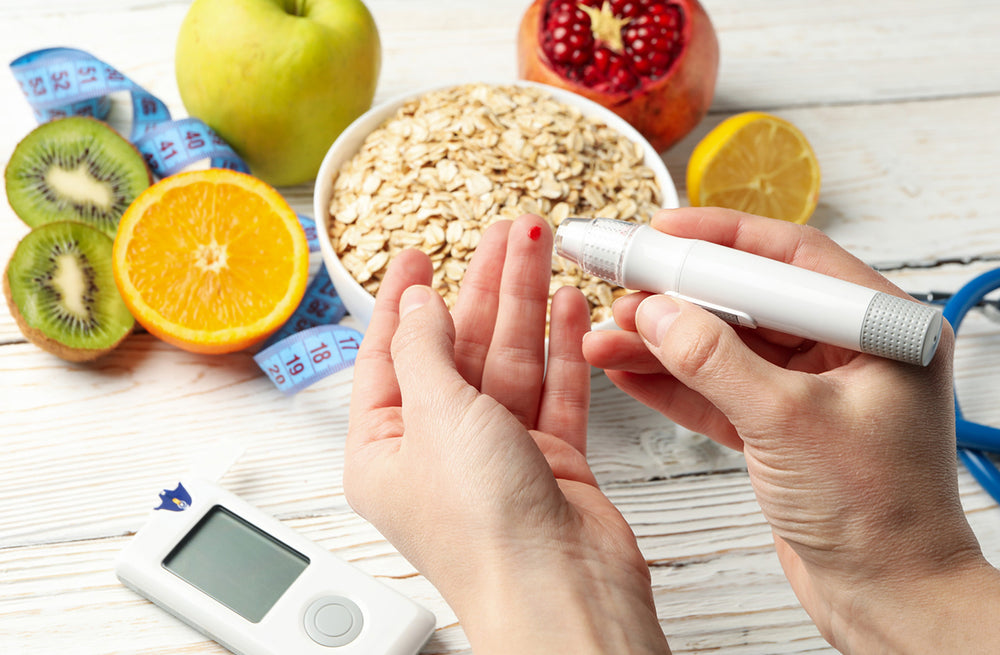Diabetes diet chart plan - best Indian diabetic meal chart
For a lot of people diabetes is a part of life and they struggle with it every day. If you are also someone who has diabetes, whether type I or type II you need to understand that lifestyle modifications and dietary restrictions are two of the most important things that can help keep your diabetes in check. When you eat a balanced diet including vitamins, minerals, and trace elements, you give your body ample nutrition. Read on to find out the best diabetic diet chart.
Best foods for diabetes
There cannot be a single diet chart for diabetic patients. The diabetic food chart needs to be customized keeping in mind your medical history, food preferences, age, and a lot of other factors. It would be best that you get in touch with a professional dietician to get a custom-made diabetic diet chart and then follow it diligently.
Here are some of the best foods that you can include in your diabetic food chart –
-
Non-Starchy Vegetables:
These are low in carbohydrates and calories but rich in fiber, vitamins, and minerals. Examples include leafy greens, broccoli, cauliflower, peppers, and zucchini. -
Whole Grains:
Whole grains are a good source of complex carbohydrates, fiber, and nutrients. They have a gentler impact on blood sugar compared to refined grains. Some options include quinoa, brown rice, whole wheat pasta, and steel-cut oats. -
Lean Proteins:
Lean protein sources can help with blood sugar management. Choose skinless poultry, fish, lean cuts of beef or pork, tofu, tempeh, and legumes (beans, lentils, and chickpeas) as part of your diabetic diet chart. -
Healthy Fats:
Monounsaturated and polyunsaturated fats are heart-healthy and can help with blood sugar control. Olive oil, avocados, nuts, and seeds are good sources of healthy fats and should be an integral part of your diabetic food chart. -
Fruits in Moderation:
While fruits contain natural sugars, they also provide fiber, vitamins, and antioxidants. It's best to consume them in moderation and choose lower glycemic index fruits like berries, cherries, and apples. -
Dairy or Dairy Alternatives:
Low-fat or fat-free dairy products and dairy alternatives like unsweetened almond milk or Greek yogurt can be included in the diet for their calcium and protein content. -
High-Fiber Foods:
Fiber helps slow the absorption of sugar and can improve blood sugar control. Incorporate foods like beans, lentils, whole grains, and vegetables in your diabetic food chart to get all the benefits.
Diet chart for diabetic patients
Managing diabetes through diet is essential, and an Indian meal plan for diabetes can be flavorful and nutritious while helping to control blood sugar levels. Here's a sample Indian meal plan for a day, keeping in mind the principles of balanced eating and portion control. Remember to consult with a registered dietitian or healthcare provider for personalized guidance, because no single diabetic diet chart can be suitable for all patients and it needs to be customized.
Breakfast
- 1 cup vegetable Dalia (Cracked Wheat) or Upma
- Side of plain Greek yogurt (unsweetened)
- 1 cup Green Tea
Mid-Morning Snack
- A small portion of mixed nuts – pistachios, walnuts, almonds
Lunch
- 2 Whole Grain Roti or 1 bowl Brown Rice
- Bowl of salad – cucumber, beetroot, onion, carrots, and tomato
- A cup of dal (Lentil Curry)
- One bowl mixed vegetable sabzi (Stir-Fried Vegetables)
- A glass of buttermilk
Afternoon Snack
- Cucumber and Carrot Sticks with hummus or yogurt-based dip
- Green tea
Dinner
- 1 portion grilled or baked fish/ paneer/ chicken
- 1 small bowl quinoa or brown rice
- Side of sauteed spinach or methi (Fenugreek) with light spices
- Small cup Masala Chai
Food chart for diabetic patient
Here’s an alternative food chart for diabetic patient that you can follow after consulting your doctor.
Breakfast
Option 1
- Scrambled eggs with spinach, mushroom, onions, and tomato
- Whole-grain toast or a small serving of steel-cut oats
- A small piece of fruit like berries or half an apple
Option 2
- Greek yogurt with a sprinkle of nuts and seeds
- Add a drizzle of honey or a small amount of fruit for sweetness
- A cup of green tea or black coffee
Mid-Morning Snack
Option 1
- A small serving of cottage cheese or paneer
- A few cucumber and carrot sticks with hummus
Option 2
- A small handful of mixed nuts (unsalted)
- 1 cup bhel puri
Lunch
Option 1
- Grilled chicken or tofu salad with mixed greens, cherry tomatoes, and a vinaigrette dressing
- A small serving of quinoa or brown rice
Option 2
- Lentil soup or dal
- A portion of steamed or roasted vegetables with light seasoning
- Whole-grain roti or brown rice
Afternoon Snack
Option 1
- Sliced cucumbers and bell peppers with hummus or yogurt-based dip
Option 2
- Low-fat yogurt with a sprinkle of cinnamon or a few berries and nuts
Dinner
Option 1
- Baked or grilled salmon/ chicken or a vegetarian protein source like tofu
- Steamed broccoli or asparagus with light seasoning
- A small serving of quinoa or brown rice
Option 2
- Spinach and lentil curry (palak dal)
- A side of mixed vegetable sabzi
- Whole-grain roti or brown rice
A diabetic diet chart that is made for your needs will ensure that you stay healthy and your blood sugar levels are in check. You can also ask your doctor and dietician what foods you can eat on a cheat day. Although here are some foods that should never be a part of a diet chart for diabetic patients -
-
Sweetened Breakfast Cereals:
Many breakfast cereals are high in added sugars. Opt for whole-grain, low-sugar options instead. -
Fatty Meats:
Fatty cuts of red meat, processed meats (like sausages and bacon), and organ meats can be high in unhealthy saturated fats. Include lean protein sources instead in your diabetic diet chart to manage your blood sugar levels. -
Full-Fat Dairy:
High-fat dairy products, such as whole milk, regular cheese, and ice cream, are calorie-dense and can impact blood sugar control. Opt for low-fat or non-fat dairy options as part of your diabetic food chart plan. -
Sauces and Condiments with Added Sugars:
Many sauces, ketchups, and condiments contain added sugars. Read labels and choose options with no added sugars. -
Sugar-Sweetened Snacks:
Snack foods like sugary granola bars and sweetened yogurts should be limited or replaced with healthier alternatives. -
Sugary Beverages:
Regular sodas, fruit juices, energy drinks, and sweetened iced teas can cause rapid blood sugar spikes. Make sure you eliminate them from your diabetic food chart to keep your health in check. -
Sweets and Desserts:
Candies, cakes, cookies, pastries, and ice cream are high in sugar and should be limited or avoided. -
Processed and Refined Grains:
White bread, white rice, and most breakfast cereals are rapidly digested and can lead to blood sugar spikes. Choose whole grains instead to be a part of your diabetic diet chart. -
Highly Processed Foods:
Many processed foods are laden with sugar, unhealthy fats, and excess salt. Check food labels for hidden sugars and additives and remove these if you want to make a successful diet chart for diabetic patients.
It is important that you follow the diabetic food chart and also take your medications on time to manage diabetes in the long run. You can also follow these tips –
Medication and Insulin: Take prescribed medications or insulin as directed by your healthcare provider. Follow the prescribed schedule and dosage. No diet chart for diabetic patients will work if you don’t take proper medication, so ask your doctor about the correct dosage.
- Learn and practice stress management techniques such as mindfulness, meditation, or deep breathing exercises. Stress can affect blood sugar levels, so finding ways to manage it is essential.
- Maintain a healthy weight or work toward achieving it. Even modest weight loss can improve blood sugar control.
- Keep track of your blood sugar levels as recommended by your healthcare team to understand how different factors, such as food, exercise, and medication, affect your levels.
- Follow the advice of your doctor and get in touch with a dietician so that you can get a personalized diet chart for diabetic patients to manage your blood sugar levels.
- Opt for foods with a low glycemic index (GI) to help control blood sugar levels. Low-GI foods have a gentler impact on blood sugar.
- Keep yourself hydrated and have 8-10 glasses of water a day.
- Avoid sugary drinks and sodas.
- Take prescribed medications or insulin as directed by your healthcare provider. Follow the prescribed schedule and dosage.
- Engage in regular physical activity. Aim for at least 150 minutes of moderate-intensity aerobic exercise per week.
- Include strength training to improve insulin sensitivity and overall health.










